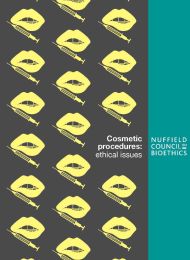Cosmetic procedures: ethical issues
Report
Published 22/06/2017

Choosing a cosmetic procedure
Current research on the motivations and influences that lead people to consider cosmetic procedures is variable in quality. More, and better, evidence is needed to provide a more thorough understanding of the field than is presently possible.
What people aim to achieve
‘Cosmetic procedures’ are many and various, and different groups of users (men / women; older / younger) are attracted to particular procedures for different reasons. However, a common theme is that people consider a procedure because they wish to ‘fit in’ with their particular peer group. Reasons that people give for having a cosmetic procedure include:
- wishing to look younger;
- aiming to look ‘normal’, often defined with respect to peer group preferences;
- hoping to improve self-esteem, or responding to body dissatisfaction;
- hoping to achieve, or maintain, professional success; and
- rejecting or conforming to social and cultural ideals.
Only a minority of people who share one or more of these aims will decide to use cosmetic procedures in order to try to achieve them. A number of influences have been identified as potentially significant in encouraging people to consider (or not to consider) cosmetic procedures as a way of achieving those aims. These include:
- the influence and attitudes of family, friends, and peers;
- the influence of celebrity, media, social media, and pornography;
- concerns with respect to sex and relationships;
- experience of being bullied or teased;
- physical discomfort (as a contributory factor alongside cosmetic aims);
- changes in the body post-pregnancy; and
- affordability.
Again, while these influences seem quite varied, a feature common to a number of them is that they make procedures seem more ‘available’, by becoming familiar, appropriate, or affordable.

Share